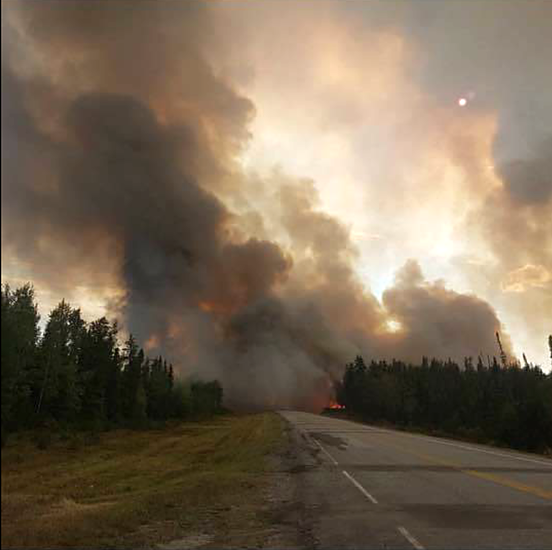
About 600 residents of Pelican Narrows will be coming to Prince Albert over the next few days as three large wildfires burn out of control in Saskatchewan’s northeast.
Pelican Narrows is the largest of the three communities threatened by the fires, and chief and council are urging residents to evacuate. Three fires are burning nearby, the largest burning over 50,000 hectares. One is a mere 3 km from the north edge of the community. Others are within 14 and 16 km of Pelican Narrows respectively.
The fires have crossed highways 135 and 106. Highway 135 is closed from north of Pelican Narrows to Sandy Bay, and Hwy. 106 from the Hwy. 135 junction to Creighton, stretches of about 70 km.
The small villages of Jan Lake, which is 3 km from a fire, and Birch Portage, which is adjacent to a fire, have already been evacuated.
The only good news for Pelican Narrows residents is the fire is not likely to damage the community.
Crews are “doing a good job of protecting the community from the direct threat of fire,” said Duane McKay, commissioner of emergency management and fire safety.
“Pelican Narrows itself is well-established, defendable space. We have lots of opportunities to defend the town. Small communities don’t have that option.”
The biggest risk to northern residents is smoke. The three large fires have blanketed the area in smoke. People with medical conditions were evacuated first, a process started yesterday. There is no mandatory evacuation order in place. While community leaders would prefer people do flee, people may stay if they choose. They may also be called on to look after community functions in the meantime.
For those who choose to stay, air scrubbers are being used to set up places they can go to shelter with clean air.
It’s not easy for those who choose to leave.
“Access in and out of Pelican Narrows is impacted by wildfire activity,” McKay said. “Access is generally restricted to late evening and early morning.”
So farm 690 people from Pelican Narrows have arrived in Saskatoon. A further 12 from that community are in Prince Albert, as are 14 people from Birch Portage. While a further 600 are so are expected in P.A., Emergency Social Services (ESS) provincial coordinator Deanna Valentine wasn’t sure when they would be arriving.
“That number is hard to pin down. We don’t know how many people are going to be able to get out of Pelican Narrows with the roads the way they are,” she said.
The number of people, and when they arrive, will depend on when they can get an escort through the closed highways and begin the journey to P.A.
“Hopefully they’ll get everyone out safely,” Valentine said.
About 3,000 people remain in Pelican Narrows.
Once the evacuees do arrive, ESS makes sure they have lodging, meals, clothing if they need it, and transportation to any local appointments. They also provide recreational activities and they work to ensure the religious and cultural needs, as well as any health and mental health care needs, are met.
That’s true regardless of where an evacuee stays, whether in the Saskatoon soccer facility turned congregate centre being used to house evacuees, or whether in hotels. The evacuees can even obtain grocery cards to get food if they’re staying with relatives to help ease the burden.
In Prince Albert, the evacuees are staying in local hotels. Normally, a congregate centre would be set up. But with the fire burning so late in the season, most of the facilities typically used for that purpose — such as schools — are not available.
While the evacuees will be cared for by ESS while they’re here, they will also receive support from the Prince Albert Grand Council (PAGC). The communities affected by the fire are all members of the Peter Ballantyne Cree Nation (PBCN), and the P.A. PBCN grounds are the first stop for many from the north.
“PAGC provides support to all of our first nations communities during emergencies,” said Richard Kent, commissioner for Saskatchewan First Nations Emergency Management.
“Whatever they need, we have our staff here at PAGC as well as all the other first nations communities looking to provide support where they can.”
According to Kent, that support can come in the form of housing, health or education.
Originally, evacuees were registering at the Red Cross building. But the space wasn’t big enough, so that first stop was changed to the Alan Bird Memorial Centre. There, evacuees register so they can receive services and find a place to stay.
“We’ve got water in there, we were having a barbecue for people who stop,” Kent said. “(We’re doing) everything we can to make a bad situation for people as comfortable as we can make it.”
One of those things is providing reliable information to the evacuees. They are being shown maps of where the fire is so they understand exactly what is going on at their home.
So far, not a lot of activities have been planned, as only a few people have arrived. But by working with provincial agencies, the grand council, PBCN and others will make sure the evacuees have everything they need.
One of those considerations will soon be what to do with the kids. School is supposed to start Tuesday. Right now it doesn’t look like those who have evacuated will be able to return to their home anytime soon.
According to Steve Roberts, executive director of wildfire management, the fires are showing no signs of slowing down.
“We expect with weather conditions, which is wind changes, and heavy unburned fuel, we will continue to see aggressive fire activity around the clock,” he said.
“We will not see any huge reprieve from a weather perspective for at least a week.”
In the meantime, the crews will do battle, “aggressively managing” the fires, Roberts said, to protect people, communities and critical infrastructure.
— additional reporting by Arthur White-Crummey
